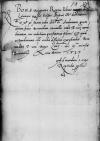Letter #1815
Bona Sforza to Ioannes DANTISCUSCracow (Kraków), 1537-12-03
| received [1537]-12-20 Manuscript sources:
| ||||
Text & apparatus & commentary Plain text Text & commentary Text & apparatus
[Reverendissi]mo in Christo Patri,
Reverende in Christo Pater, sincere nobis dilecte.
Audivimus grato animo hunc
Bene valeat Paternitas Vestra.
Datae
Ad mandatum sacrae reginalis maiestatis proprium

